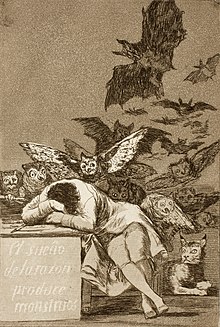Los caprichos: Difference between revisions
m tense |
needs sections per WP:MOS |
||
| Line 1: | Line 1: | ||
{{sections|date=July 2009}} |
|||
[[Image:Goya-El sueño de la razón.jpg|thumb|''El sueño de la razón produce monstruos'' – ''[[The Sleep of Reason Produces Monsters]]'' ]] |
[[Image:Goya-El sueño de la razón.jpg|thumb|''El sueño de la razón produce monstruos'' – ''[[The Sleep of Reason Produces Monsters]]'' ]] |
||
Revision as of 08:54, 6 July 2009
This article needs to be divided into sections. (July 2009) |

Los Caprichos are a set of 80 aquatint prints created by the Spanish artist Francisco Goya in 1797 and 1798, and published as an album in 1799.
The prints were an artistic experiment: a medium for Goya's condemnation of the universal follies and foolishness in the Spanish society in which he lived. The criticisms are far-ranging and acidic; he speaks against the predominance of superstition, the ignorance and inabilities of the various members of the ruling class, pedagogical short-comings, marital mistakes, and the decline of rationality. Some of the prints have anticlerical themes. Goya described the series as depicting "the innumerable foibles and follies to be found in any civilized society, and from the common prejudices and deceitful practices which custom, ignorance, or self-interest have made usual".[1]
The work was an enlightened, tour-de-force critique of 18th-century Spain, and humanity in general. The informal style, as well as the depiction of contemporary society found in Caprichos, makes them – and Goya himself – a precursor to the modernist movement almost a century later. The Sleep of Reason Produces Monsters in particular has attained an iconic status.
Los Caprichos were withdrawn from public sale very shortly after their release in 1799. In 1803 Goya offered the Caprichos' copper plates and the first edition's unsold sets to King Carlos IV. Later in life Goya wrote that he had felt it prudent to withdraw the prints from circulation due to the Inquisition.[2]
Goya added brief explanations of each image to a manuscript now in the Prado; these help greatly to explain his often cryptic intentions, as do the titles printed below each image.
Gallery
-
Todos caerán - "All will fall"
-
Aquellos polbos - "Those specks of dust"
-
¿Porqué fué sensible? - "Why was she so simple/humble?".
-
Corrección - "Correction"
-
Lo que puede un sastre - "What a tailor can do"
-
Volavérunt - "They have flown"
-
Allá va eso - "There it goes"
-
Nadie nos ha visto - "Nobody has seen us"
References
- ^ Simon, Linda, "The Sleep of Reason", The World and I
- ^ Boime, 264
- Albert Boime, A Social History of Modern Art. University of Chicago Press, 1991. ISBN 0226063356.
- John J. Ciofalo, The Self-Portraits of Francisco Goya. Cambridge University Press, 2001.
External links
- Caprichos (PDF in the Arno Schmidt Reference Library)








